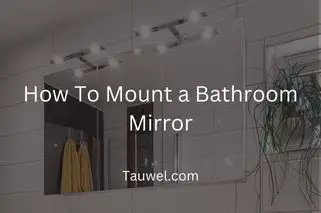This post contains affiliate links. Read the full disclosure here.
Hanging pictures can go horribly wrong if they are not aligned properly. They can add a lot of life to your home. Pictures are not only a great source of looking at memories but also add a lot of aesthetic features to a room. Hanging pictures can seem like an annoying task. Anybody who has attempted this before knows how annoying it can be to make all the effort only to be left with a lopsided picture. Let’s take a step-by-step look at how to correctly hang a picture.

Depending on the size and weight of the picture, you can either use adhesive strips or drill a screw into the wall. To ensure that the frame is level, you can use either a spirit level or a laser level. Using a spirit level is quite easy, simply place the level on the top edge of the picture frame and ensure that the bubble is correctly centered.
Contents
How To Use a Spirit Level?
A spirit level is one of the most common tools in a carpenter’s arsenal. It can also be a great tool for DIY home use. They are quite inexpensive and help to get the job done for most tasks.
In a Hurry? Don’t go without checking this TRENDING Topic Out - 6 Best Towels For Blackstone Griddle In 2022 out
A spirit level consists of a bubble in the middle of the device which moves according to the alignment. If a surface is perfectly aligned, the bubble will stay in the middle, the bubble will move in the direction of the incline.
Using a spirit level is very straightforward. Simply put the level on the surface you want to level. The bubble will indicate if the surface is level, or tilted to either side.
How To Use a Laser Level?
A laser level is one of the most accurate tools to ensure that your pictures are going to be perfectly aligned. There are different types of laser levels in the market. Some need to be leveled manually, others can level themselves. There are also variants that project a 360 laser that fills all the walls in a room while others simply project either a single line or two perpendicular lines on a single wall.
The right laser level depends on your usage. If you only want to hang a few pictures and there is no further use of the laser level, then going for a manual or self-leveling single or double line level would get the job done.
To level a laser level manually, attach the laser to the wall where you want to hang the picture and make sure the laser crosses the point on the wall where the edge of the frame would be. Look at the small bubble on the level and make sure it is perfectly centered. If the level is not aligned, the bubble will move either to the left or the right.
A self-leveling laser level on the other hand is quite simple to use, just attach it to the wall or on a tripod and turn it on, and it will align itself. One thing to note is that these levels will be more expensive. They are ideal for situations where you will have to repeatedly align the level.
Different Methods Of Mounting Or Hanging a Picture
Depending on the size and weight of the picture you want to hang, you can opt for different methods. While using adhesive strips is inexpensive and easier, it won’t be a permanent solution and can only support up to a certain weight limit.
Using nails, clips and a wire will be a bit more complicated but is ideal for larger pictures and if you want a more permanent solution.
Using Adhesive Strips
One of the best adhesive strips in the market is offered by Command in the form of strips. They are extremely easy to use and don’t leave any marks on the walls. One of the other benefits is that the company offers different kinds of strips for different strength levels, users can also use them in combination to be able to support more weight.
While using adhesive strips, attach one part of the strip to the back of the picture frame and keep it aside. While attaching the strip, make sure it is perfectly centered using a ruler and a pencil.
Stick the other part of the strip the one already attached to the picture frame.
Take a pencil, a ruler, a spirit level, or a laser level, and draw a straight line on the wall where you want to hang the picture. The straight line should be aligned using the level you have. Keep the spirit level on top of the ruler on the wall and as the bubble reaches the center point, draw a line on the ruler.
Similarly, you can attach the laser level at the height where you are hanging the picture and once the level is leveled, draw a line along that laser.
Now peel off the plastic layer from the adhesive strip without separating it from its pair on the frame. This way you can simply take the frame and press it against the wall, aligning it with the line you drew before.
Erase the line and your picture frame is good to go.
Using Nails, Clips, And a Wire
If you are going to be using a nail or clips to hang the picture, there should either be a wire at the back of the picture frame or hooks to attach itself to the clips.
If there is neither at the back, you should ideally attach two hooks near the opposite edges of the frame as this will be relatively easier when compared to attaching a wire.
Using Clips And Hooks
Once you have attached a pair of hooks to the back of the picture frame, keep the picture in front of the wall and mark the top edges using a pencil.
Keep the picture aside and measure the distance from the hook to the top of the picture frame. Also, measure the distance between the hooks themselves and their distance from the edges. Mark these measurements on the wall.
For the top edges which you had marked before, mark a point below it at the measured distance, keeping the required distance from the side edge as well. Do it for both clips and double-check the measurements before moving forward.
Once the points have been marked, use a spirit level or a laser level to ensure that it is perfectly aligned.
Depending on the type of wall, you will have to drill holes into the wall at the marked points. You will need an electric drill, the appropriate drill bits, and anchors in case you are not drilling into a stud behind the wall. The anchor will provide the extra grip required to hold onto the picture.
Drill an empty hole into the wall and hammer in an anchor until it is flush with the wall, don’t use too much force otherwise, it might damage the wall.
If you have a plaster or lathe wall, use a Molly anchor which expands once it is inside the wall. This is done because of the lower grip strength of these walls.
Once the anchor is in, take the clip and drill a screw through it into the anchor until it is snug and tight. You can also use a screwdriver here.
Once both the clips are placed, take the picture and slide the hooks into the clips and you are good to go.
One Hanging Point
If there is a wire at the back of the frame and you intend to only use one nail as the hanging point then the aligning steps are quite straightforward.
Hold the picture up to the wall and mark the top edges. Measure the height between the top of the frame and the point where the wire has the most tension behind the frame. Mark the center point of the frame before doing this.
At the center point of the frame on the wall, mark a point below the top edge based on the measurement you took earlier.
Drill a screw or a hook into the wall at the marked point following the steps above. Now take the picture and fix the wire on the hook or nail.
Next, take a level and check if the picture is aligned or not using its top edge. Place the spirit level on top of the frame or attach the laser level at the frame height.
Adjust the placement of the frame using the wire at the back until it is perfectly aligned.
Two Hanging Points
With two hanging points, the alignment process will happen at the drilling points on the wall. Most of the steps will be the same. The difference is that rather than marking one point at the center of the wall, you will have to mark two points on the same line equidistant from each other and the side edges of the frame.
For this, turn the picture around and make the wire tied at two points. Measure the distance between these points and their distance from the edges. Transfer these measurements to the wall and mark the points appropriately.
Use a level here to ensure the two points are perfectly aligned. Once it is done, drill the holes and hang the picture. Use a level again to ensure that it is aligned.
Conclusion
When hanging pictures, curtain rods, or towel bars, a spirit level or a laser level is essential to the process. A spirit level is cheaper but it can be a hassle to use if you want to hang many things. A laser level on the other hand has a lot of variations in the market, with some projecting 360-degree lasers and some being able to self-level themselves.



